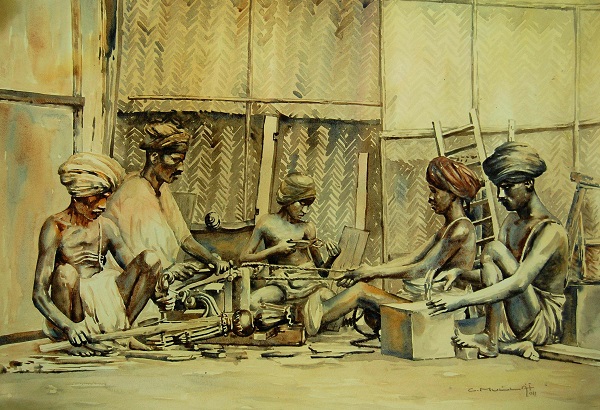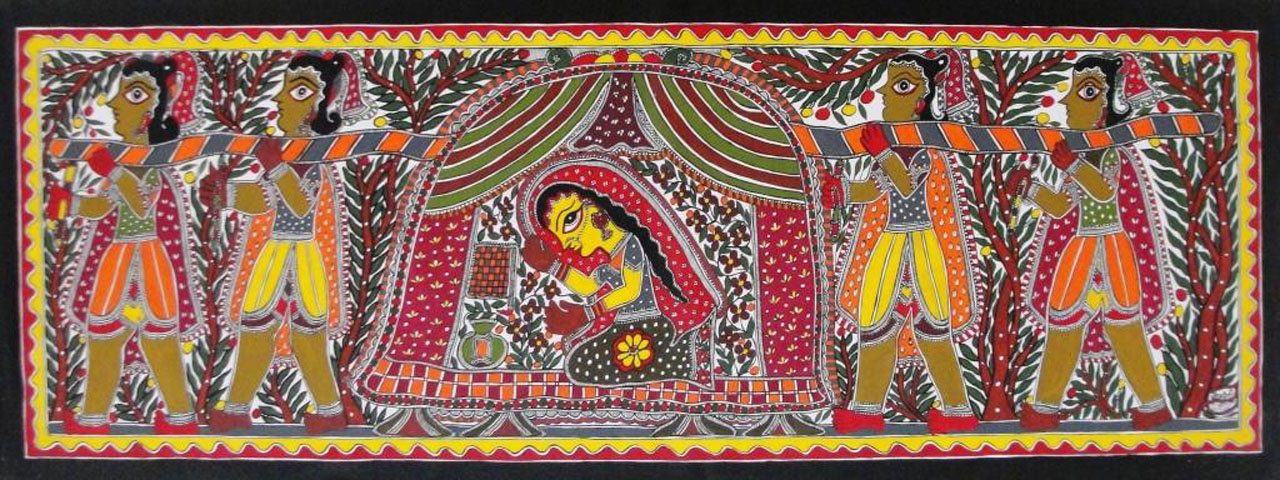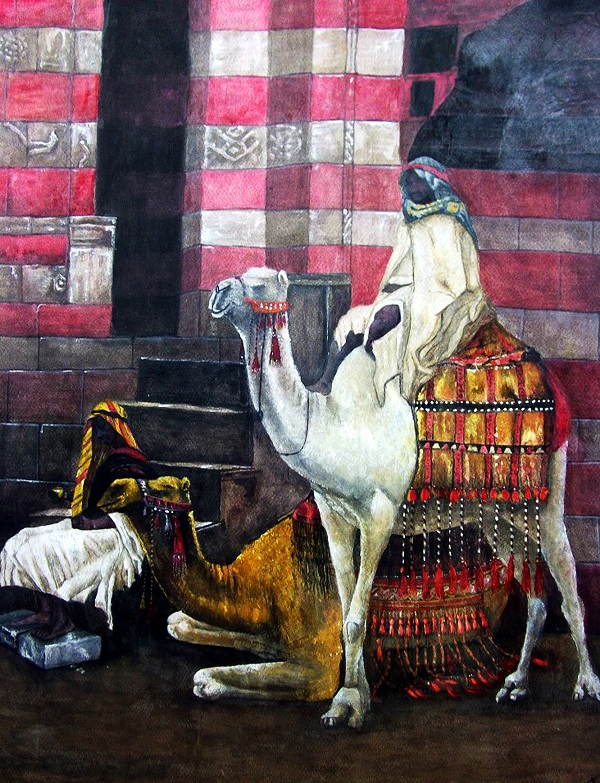
Claude Debussy famously observed, "Art is the most beautiful of all lies."
Within the vibrant tapestry of global visual expression, few traditions match the intricacy and profundity of Indian Traditional Art. Meanwhile, Indian paintings show a centuries-long cultural tradition that encompasses narrative, spirituality, and a unique style, much like a colorful kaleidoscope.
The well-known artist Edgar Degas once said, "Art is not what you see, but what you make others see."
The mesmerizing brushstrokes of traditional Indian paintings display more than just colors on canvas; they are a visual symphony that tells the story of a nation.
Have you ever wondered why Indian traditional arts hold up so well throughout time, keeping not just vivid colors but also a wealth of cultural heritage?
We'll examine the many brushstrokes, delve into the colors that transcend time, and discover why Indian traditional art is a living testament to a country's spirit rather than just a stunning exhibition.
By examining its historical roots, the cultural fabric it weaves, and its ongoing value, this comprehensive blog will highlight the essential significance of Indian traditional art.
From the vibrant miniatures of Rajasthan to the dreamy landscapes of Tanjore paintings, every brushstroke on the canvas captures the pulse of India and the spirit of tradition that echoes through the ages.

A Historical Tour of the Inception of Traditional Indian Painting
The creative traditions that trace back to the Indus Valley Civilization have been nurtured in India, the cradle of ancient civilizations. Early painters created paintings and sculptures for temples and caves as part of religious rites, which is where traditional art got its start. Indian traditional art gained a unique sense of depth and purpose from this spiritual connection.
A Cultural Canvas: Indian Traditional Paintings' Symbolism
In addition to being beautiful works of art, traditional Indian paintings provide windows into the vibrant cultural landscape of the nation. From opulent depictions of legendary tales to the meticulous craftsmanship of Pattachitra paintings, each stroke conveys a story while upholding tradition, conventions, and cultural nuances.
Timeless Methods: The Artists Producing Customary Indian Paintings
Traditional Indian paintings are in and of themselves masterpieces. Generation-after techniques show a commitment to preserving time-honored methods, such as the meticulous application of natural colors in Madhubani paintings and gold leaf embellishments in Tanjore art.
The Colors of Tradition: A Significative Color Scheme
In Indian traditional art, colors have deep symbolic meaning that extends beyond their aesthetic appeal. The blues of Pichwai paintings symbolize the heavens, while the reds and greens of Rajasthani miniatures symbolize love and fertility. Explore the symbolism behind these colors to learn more about their spiritual and cultural components.
The Confluence of Tradition and Modernity: Modern Relevance
Despite its deep history, Indian traditional art has continued to evolve. Modern viewers find the dynamic mix created by the art style's gentle acceptance of contemporary elements appealing. To keep the tradition alive and relevant, artists of today draw inspiration from it and add new ideas to it.

Syncopate Cultural Symphony of Traditional Indian Art
The cultural orchestra of India is represented by the pictures in its traditional art, which is like a symphony with each picture playing a different note. Whether it's the rhythmic pulses of Warli art or the melodic swirls of Mughal miniatures, these many forms add to a cultural symphony that resonates beyond regions, languages, and customs.
Identity as Tradition: How Indian Traditional Art Identifies and Brings People Together
In a nation as diverse as India, traditional art serves as a unifying element. Through common narratives depicted on canvas, it offers a global language that transcends linguistic and regional limitations, enabling people from all backgrounds to engage. Because of this, traditional art becomes a powerful tool for defining and preserving the country's shared identity.
The Legacy of Master Craftsmen: Preservers of Tradition
An authentic Indian artwork has the signature of skilled artisans in every stroke. These seasoned craftspeople, many of whom are descended from families, dedicate their lives to perfecting the exact techniques and passing them down through the years.
Conventional Art as a Creative Inspiration Source
Both a mirror of the past and a source of inspiration for contemporary artists may be found in traditional Indian art. Modern painters find a rich source of inspiration by delving into the techniques and narratives of classic paintings, creating a creative continuity that crosses generations.
Cultural Resilience: The Triumph of Conventional Art Despite Adversity
Despite the passing of time and the emergence of new creative movements, traditional Indian art has endured. Its adaptability without losing its fundamental essence illustrates the enduring essence of Indian origin. By guaranteeing that the tales it tells will endure through the years, traditional art takes on the role of a guardian of cultural continuity.

Summing Up!
In the vast fabric of Indian heritage, traditional art manifests itself not only as a static reflection of aesthetics but also as a dynamic force connected to history, culture, and identity. Claude Debussy's wise words, "Art is the most beautiful of all lies," have endured through the ages, perfectly capturing the essence of ancient Indian paintings.
Inspired by Edgar Degas's insight that "Art is not what you see, but what you make others see," we explored the mesmerizing brushstrokes of Indian inventiveness and came upon a narrative that transcended simple paintings on canvas. Every brushstroke, hue, and custom conveyed a story—a timeless narrative that mirrored the pulse of a country.
It becomes clear why Indian traditional paintings have been around for so long. This is the first question that is posed. Through a combination of cultural symbols, historical underpinnings, enduring customs, and a flexible spirit, this inquiry reveals the essential solution.
Though as ageless as Tanjore landscapes and as vibrant as miniatures from Rajasthan, traditional Indian art is a living testament to the nation's identity rather than a relic from the past. Each stroke on the canvas represents a commitment to legacy and a statement of tenacity in the face of changing circumstances, from its origins in the Indus Valley Civilization to its contemporary alterations.
In the enormous collection of human expression, traditional Indian art stands as a masterpiece, calling us to be in awe of its beauty, acknowledge its cultural significance, and continue its heritage. It serves as a connection between generations, a mirror reflecting the past, and a protector, making sure that tradition's hues never run out on the canvas of India's vast and varied history.
FAQs:
How can traditional Indian paintings help to maintain the identity of a culture?
A visual representation of India's cultural essence may be seen in traditional Indian paintings. As a uniting force that cuts beyond linguistic and geographic differences and forges a common cultural identity, they stand for local customs, folklore, and social nuances.
What is the story behind the preservation of the great painters responsible for traditional Indian paintings? Who were they?
A lot of the renowned artisans who create traditional Indian paintings are descendants of families, and their signatures are often seen in these works. These skilled craftspeople commit their whole lives to perfecting techniques, making sure that the legacy is preserved for future generations, and maintaining the originality of the art form.
What impact does Indian traditional art have on modern artists?
Modern painters get inspiration from the traditional Indian art form. To introduce novel perspectives and ensure the survival of artistic traditions, contemporary artists draw inspiration from the techniques, narratives, and cultural diversity of historical painters.
How does traditional Indian art stay faithful to its roots while adjusting to new circumstances?
The ability to adapt to changing creative trends without losing its essential qualities is a sign of the longevity of traditional Indian art. To achieve a balance between history and modernity, artists include contemporary elements in their work to ensure that it remains relevant for future generations.





















